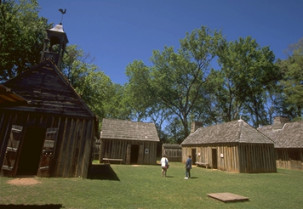
Fort St. Jean Baptiste
Fort St. Jean Baptiste State Historic Site
155 Rue Jefferson, Natchitoches, LA 71457
318-357-3101 or 888-677-7853 toll free
Email: fortstjean@crt.la.gov
It's located on the banks of the Cane River between downtown
Natchitoches and Northwestern State University, minutes from I-49. Facilities
include the fort replica with the addition of modern restrooms. Groups
are requested to arrange a tour.
Outpost on the Edge of an Empire
Natchitoches was founded by a French Canadian, Louis Antoine Juchereau
de St. Denis, in 1714 while he was en route to Mexico from Mobile, Alabama,
on a trade mission. When he reached the village of the Natchitoches
Indians on the Red River, he had two huts constructed within the village
and left a small detachment there to guard the stores and trade with
the inhabitants. This became the first permanent European settlement
in the territory later known as the Louisiana Purchase.
In 1716, Sieur Charles Claude Dutisné was sent to Natchitoches
with a small company of colonial troops to build and garrison an outpost
that would prevent the Spanish forces in the province of Texas from
advancing across the border of French Louisiane. This strategic outpost
was named Fort St. Jean Baptiste des Natchitoches. Economically, Natchitoches
evolved into a primary French trade center in the Lower Mississippi
Valley. Native American tribes of the three Caddo Confederacies played
a vital role in establishing trade and communication links among the
French, the Spanish and the Native Americans of the region. The trade
that developed with the Caddos forever changed the material culture
of the tribes, and by the mid-18th century they were almost completely
dependent upon French trade goods. The diplomatic success of the fort
was assured when St. Denis was named commandant in 1722. His influence
would thrive in the colony until his death in 1744.
A detailed drawing made in 1733 by the French Engineer-in-Chief Sieur
Ignace Francois Broutin shows the improvements made to Fort St. Jean
Baptiste. In August 1732, Broutin was sent by the Commissary General
of Louisiane "to see what had to be done to the fort and to put
this garrison in security," which was then menaced by the Natchez
Indians. Upon his arrival, he found St. Denis "had the stakes of
the enclosure changed from top to bottom by the soldiers and inhabitants
and redoubled inside by the other smaller ones." This produced
a palisade of double thickness, an unusual feature in colonial Vauban
fortifications.
Broutin remained in Natchitoches until the end of the year, during
which time he constructed a "crude barracks, a warehouse and a
house for the warehouse keeper." No sooner had the construction
begun than the Spaniards of nearby Los Adaes protested that it was an
invasion of Spanish territory, a protest that St. Denis politely acknowledged
and ignored.
Troupes de la Marine
Between 1716 and 1762 the fort was garrisoned by independent companies
(Compagnies Franches de la Marine). Functioning under the Ministry of
the Marine, they were charged with the administration and defense of
the French royal colonies. Marines served dual duties as soldiers and
policemen in the small frontier settlement. While most of the enlisted
men of the companies were recruited in France, young aristocratic Canadians
served as officers. Many settled in Natchitoches before or during their
enlistment, or after their enlistment expired, as it was the Ministry's
intent that these Marines become part of the community they served.
In addition to the average 40-man companies, the fort included an ordnance
consisting of two four-pound naval guns and two one-pound wall-mounted
swivel guns.
The French Withdrawal from Louisiana
The fort continued to serve as a military outpost and commercial trade
center until 1762, when France's defeat by England in the French and
Indian War forced her to cede the Louisiana colony to Spain. Under Spanish
authority, the fort served as a trade center and a link in Spain's intracolonial
communications network. But since its original purpose of protecting
a territorial boundary no longer applied, the Spanish eventually abandoned
the fort. The fort was in such ruins by the time the United States acquired
the area in the Louisiana Purchase (1803) that the Americans could no
longer use it, so they built Fort Claiborne nearby.
Full-Scale Replica
The site obtained for the replication of Fort St. Jean Baptiste is
located on Cane River Lake (formerly the Red River) a few hundred yards
from the original fort site. The fort replication was based upon Broutin's
plans and on extensive archival research in Louisiana, Canada and France.
Construction began in 1979 under the direction of the late Samuel Wilson,
Jr. and the Louisiana Office of State Parks. Building materials were
obtained locally, and many 18th-century techniques were employed in
the replication. Nearly 2,000 treated pine logs form the palisade and
approximately 250,000 board feet of treated lumber went into the construction
of the buildings. All of the hinges and latches were handmade at a nearby
foundry. Further historical research is ongoing.
Living History History Programs
With the completion of Fort St. Jean Baptiste State Historic Site,
the Office of State Parks initiated an interpretive program that provides
the visitor a unique opportunity to experience our early colonial history.
Each year, the park hosts several 18th-century living history encampments
and programs in which the multicultural heritage of the colony is interpreted
for the visitor.
We hope that your visit to Fort St. Jean Baptiste State Historic Site
will give you a better understanding and appreciation of the customs
and cultures of the early inhabitants of Louisiana.
Communities and Related Links
|